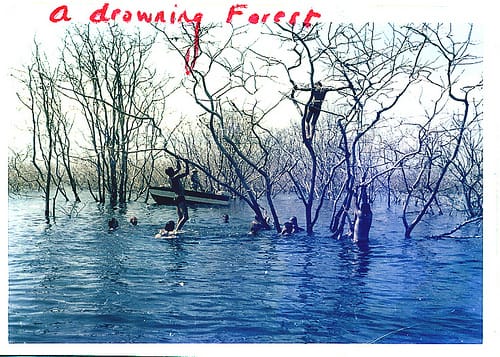Noah's Stockings

On holiday with the Atkinsons and De Beers in the drowning mopane forest at Lake Kariba 1964.
Noah’s Stockings
1916 was the last time lions were seen in Que Que. Sir Roy Welensky, the prime minister, famously said, “You can’t run a farm and a zoo.” Tsetse flies are the carriers of nagana, animal tripanosomiasis (sleeping sickness). The Southern Rhodesia game department, in an effort to control tsetse fly, shot over 300,000 wild animals in a big belt of country south of the Zambezi Valley. In the Valley itself, wild animals still abounded.
Noah’s Stockings
Before Kariba Dam was completed in 1959, on a remote stretch of the Zambezi River, a 2000 square mile lake began to form rapidly behind it. The Batonka people had been resettled in anticipation. It was expected that the game would head for higher ground too as they always did in the rainy season.
However, game from aardvaks to zebras headed in many instances for the wrong hills, that would soon become ever decreasing islands, finally submerging altogether.
Something needed to be done, and fast! Senior Ranger, Rupert Fothergill of the game department with 60 African wild life wardens set out with two motor launches and 5 small boats to rescue the animals, large and small, from the valley.
They had a limited budget. Primitive rafts were constructed out of 44 gallon drums strapped together. Nets, boxes, sacks, cages, traps, ropes, drugs, darts and fuel for the boats and food for the team were assembled. The valiant band captured the hearts and minds of the country. The British Sunday Mail brought the mission worldwide publicity and offers of funding. These were declined for fear of foreign interference. It continued on a shoestring budget.
Fothergill and his team noticed that ropes cut into the legs of the bound animals. He sent out a plea for nylon stockings. Plaited, these provided a strong but soft alternative.
I was too young, my mother thought, for high heels and nylon stockings. Fifty yard petticoats were all the rage. I wore one under cotton frocks with gathered full skirts, bobby socks and patent leather shoes. Women dressed up to go to town. Stockings were a must, so the average housewife went through quite a few. They were thigh high, held up with suspenders which had a habit of losing their buttons that held them up. Aspirins, just the right size, were the perfect substitute. Stockings laddered easily. They didn’t make good rags the way men’s soft cotton underpants did for weekly polishing of the silver or washing down the car.
We were a frugal society and recycled and conserved everything. My mother did all her baking for the week in one day, to conserve electricity. Every rack was filled, the trays of biscuits, ginger bread loaves, and brown bread juggled around so they didn’t burn on the bottoms or brown too much on the tops. Meringues were popped in last and left in over night as the oven cooled down. Kariba would give us cheap hydroelectricity.
The SPCAs were deluged with stockings.
Fothergill discovered many animals like antelopes and baboons could swim. These were shepherded to Matusadona, a non-hunting area on the mainland, while the rest were driven into nets or into the water for easier capture. They pioneered darting big game like rhinos with tranquillizers. Then they were roped, trussed on stretchers and hauled by gangs of wardens to the waters edge, slid onto pontoons and floated to safety.
I was lucky, as the daughter of a member of Parliament, to witness Operation Noah. Over six thousand animals were rescued.
We have our own home cine but have yet to transpose it to a DVD. Here is an excerpt from Rhodesian Spotlight made possible through Memories of Rhodesia. (This video is much more dramatic than ours! Take a look.)
http://www.youtube.com/watch?v=_xaKRk870JU&feature=related
Also see epic pictures of the building of Kariba made available by Alan Smith on Eddy Norris’ web site:
http://rhodesianheritage.blogspot.com/2011/05/kariba-gorge-scheme.html
